new posts in all blogs
Viewing Blog: SpeakWell, ReadWell, Most Recent at Top
Results 1 - 25 of 126
A speech, reading & storytelling blog.
Statistics for SpeakWell, ReadWell
Number of Readers that added this blog to their MyJacketFlap:
I’ve been buzzing around our school campus lately—testing students, writing progress reports and attending into-the-evening parent-teacher conferences. Fortunately, I had time during one rainy-day recess to share a story with a group of enthusiastic second graders. I enlisted their help in interviewing the author, Lauri Fortino, about her book, The Peddler’s Bed. The story kept these cooped-up-on-a-rainy-day students in their seats and captivated by Bong Redila’s illustrations.
Welcome, Ms. Fortino! My students enjoyed your book and have a few questions for you.
Chloe: How long did it take you to write this book?
Lauri Fortino: It took about a day to write the story. But it took over a year for the illustrator to draw and paint all of the pictures. Then the publisher had to put everything together in the right order, make sure it looked perfect, and send it to the printing company to be made into a real book. From the time I wrote the story to when it became a book, it took almost two years!
Hunter: How did you come up with the idea for this story?
Lauri Fortino: The idea for this story mostly came from feeling grateful to family and friends for being generous and kind to me. But I’ll let you in on a secret—I also got the idea because my husband and my dog both snore. And sometimes their noses squeak while they’re sleeping!
The kids had a good laugh about those squeaky noses and they did an excellent job imitating the squeaks and snorts they hear in their own homes.
Kaylee: How many books have you made up?
Lauri Fortino: So far, I’ve written around forty-five stories, but they’re not all finished yet.
Karson: Do you have lots of ideas for other stories?
Lauri Fortino: I have ideas for over one hundred more books.
Andy: How do you get your ideas?
Lauri Fortino: Story ideas come to me in many ways. I get ideas from dreams. I wrote a dinosaur story based on a dream I had when I was a kid. I also get ideas for stories from places I visit and activities I do with family, friends, and my dog. Sometimes I get ideas from reading other books, or from observing people, animals, and nature.
Jose doesn’t have a question but he wanted me to tell you that he has a toy cart with a horse that looks just like the one in your book.
Lauri Fortino: That’s awesome! I love horses! I learned how to drive a horse and cart and it was so much fun!
Hannah: This is a nice book—are you famous?
Lauri Fortino: Thank you! No, I’m not famous. But maybe I will be someday.
Eric: How did you choose the illustrator? How did you know he would make good pictures?
Lauri Fortino: The publisher of my book chose the illustrator. He saw some pictures that Bong Redila had drawn and he liked them. He asked Bong if he’d like to illustrate the story and he said “yes.” I think he did an excellent job!
We think so too!
Keelan: When did you make your first book?
Lauri Fortino: I was about your age when I started writing stories. I made my own books out of paper I stapled together. Then I wrote the stories and drew the pictures inside.
Vanessa: Did you think of having the birdhouse on the cart or did the artist come up with that idea?
Lauri Fortino: That was the artist’s idea. I think it’s pretty neat! I like the round baskets too and how everything is so colorful. The trees are one of my favorite parts of the book.
Duke: How did you make such tiny words without messing up?
Lauri Fortino: Great question! The printing company printed all the words onto the pages of the book. Printing companies have machines that can print words and pictures in any size they want.
Arianna: How did you make the book?
Lauri Fortino: I had a lot of help making the book. First, I wrote the story. Then the illustrator drew and painted all of the pictures, including the ones on the front and back covers and on the jacket flaps. Then the publisher put everything together and sent the pages to the printer to be made into a real book. The printing company printed hundreds of copies to send to bookstores all over the country so that people could buy them.
Several students enjoyed the kind characters in the story and that made them want to know more about you – the author.
Johann: Do you like eating bananas?
Lauri Fortino: Yes! I enjoy eating bananas, especially in a banana split with three kinds of ice cream, chocolate syrup, whipped cream, and pineapple. Yum!
Eli: cookies?
Lauri Fortino: Chocolate chip cookies are my favorite.
Alia: What is your favorite thing to do?
Lauri Fortino: My absolute favorite thing to do is write stories. I also love to spend time with my dog. His name is Java. He’s super smart. When I ask him to show me his belly, he’ll lie down and roll over on his back. I’ll send a picture to share with everyone.
Thank you for the picture – we think Java is adorable!
Marcos: Are you rich?
Lauri Fortino: No. It’s hard to get rich writing books. But it’s a lot of fun.
To wrap up our interview, do you have any advice for young writers?
Lauri Fortino: Use your imagination and write stories about people, places, and things that interest you. If you do that, you’ll always do your best writing. If you dream of one day becoming an author like me, your dream can come true.
October has arrived along with crisp rustling leaves, mounds of pumpkins, and requests for Halloween stories in the speech room. One repeated request is especially pleasing, “Read the ghost story. The one with a g - g - g ghost!” Today, when I turned the last page, several children said, “read it again!” I haven’t told them I’m the author. After all, I want unbiased reactions to my work and I’m thrilled with the ones I’m getting.
Since this book has been so popular with my students, I wanted to share it with you. I’ve created an eBook that’s available for free on Amazon for a limited time.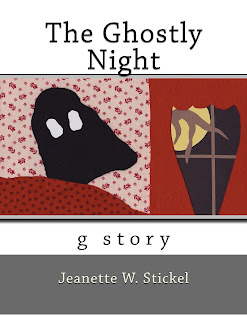 |
| Click to go to Amazon for your free book |
I wrote the story to give my students an engaging way to practice their “g” sounds but it’s also a good fit for Halloween.
In THE GHOSTLY NIGHT Kristy can’t sleep.
“The wind rattled her window. The full moon threw grasping shadows across her bedroom wall. They swayed with the rhythm of the wind.”
“Mom!” she cried. “There’s a g - g - g ghost in my room!”
Kristy calls again when the wind howls, when a branch scrapes her bedroom window, and when she sees her curtains move. Each time, the kids join in “reading” the repeated line, “There’s a g - g - g ghost in my room.” They can’t seem to help themselves. That makes for a lot of practice with the “g” sound. It also gives them an understanding of the sound the letter represents, a phonemic awareness skill that fits right in with the Common Core State Standards (especially RF.K.3a where students are expected to “Demonstrate basic knowledge of letter-sound correspondences by producing the primary or most frequent sound for each consonant.”)
One teacher told me her whole class erupted in clapping when the tables turned on the Mother at the end of the story. You can imagine how pleased I was to hear that report—almost as pleased as I was when I breathed in the autumn-crisp air this morning and poured a cup of cinnamon-spiced tea.
I hope you’re enjoying the season as much as I am and I hope you’ve found a good supply of autumn books to share with the children in your lives, and several more for yourself!
If you visit my blog regularly, you might have noticed I haven’t written for a while. I returned to work the day after my trip to Alaska and was swept up in a whirlwind of activity—both at work and at home. We are short one speech therapist in our school district so a couple of us are filling in and working extra hours. On the home front, MY OLDEST SON GOT MARRIED. I hope you’ll interpret those capital letters as excitement or joy—I’m filled with both! If you have ever helped with wedding preparations (including baking the wedding cakes), you’ll forgive my time away from posting. I felt compelled to return to my blog after sharing a new book with my students. THE BUG BOOK by Sue Fliess.
This rhyming text and accompanying photos captured my students’ attention.
Grab you bucket. Check your guide.
Let’s go find some bugs outside!
Fast bugs,
Slow bugs,
Off-they-go bugs.
Hop bugs,
Fly bugs,
Way-up-high bugs.
My transitional kindergarten students were squirming with excitement and practically crawled across the table for a closer look at the insects. My kindergarten and first grade students scrambled to be the first to identify the bugs in the photos and my second grade students started creating bug books of their own. Some are writing nonfiction as they identify the insects in the BUG BOOK to create their own guide. Calvin and Garrett are writing fiction. Their characters, Ducky, Anty and Flower the ladybug, were good friends until an ice cream truck dropped a load of chocolate mint ice cream in the park. Their friendship cooled but they solved their problem by sharing, then celebrated with ice cream sundaes topped with honey, bread-crumbs and aphids! (They had to do a bit of research to find out what their characters might want for toppings.)
This book inspired wonderful creativity, artwork, and research. Take a look at some projects from our speech room:
These talented artists would have been a big help decorating the wedding cakes but I’m glad I didn’t enlist their help with the toppings!
My summer vacation is almost over and I’ll be back at school next week, but for now I’m enjoying my summer’s end with family, old friends and beautiful scenery in Juneau Alaska, where I lived years ago.
We’ve seen wildlife,
checked out some island settings for a story I’ve been working on,
and enjoyed a whale watching boat ride with plenty of action, even a group of humpback whales forming a bubble net. These clever mammals work together, blowing air bubbles beneath a school of herring then surface, mouths wide open to swallow the trapped fish.
We’ve enjoyed hikes along the Mendenhall glacier,
beside waterfalls,
 |
| My husband and I |
and a good climb up Mt. Roberts.
 |
| My husband and niece, Kate |
If you are an educator, I hope this new school year will bring many mountain top experiences for you and your students,
maybe not the literal kind, but who knows, it would certainly make an interesting field trip!
A few years ago, a young student told me his family was moving. I was sad to hear the news. I was going to miss his charming and somewhat mischievous personality. I contacted his mom and she explained they were moving to be closer to her family. Our school secretary gathered records to go with them and contacted the school to let them know the family was coming.
A couple of months later we got a call from a school in a different town, where my student had just enrolled. This town was about half way to their target destination and when our secretary registered surprise, the person on the other end of the line explained, “They got a flat tire.”
A flat tire—so they didn’t make it to the town where they’d have family support and they didn’t make it to any school for a couple of months. It is hard to imagine how a flat tire could determine such important decisions, like where you will live, and where your children will receive an education, but for some people, a flat tire is much more than an inconvenience.
I tell this story because we don’t always know the challenges a student faces in life and how competent their parents are in guiding them through it.
We all need this reminder occasionally and Kyle Schwartz, in her book, I WISH MY TEACHER KNEW, does this brilliantly.
Her book was inspired by a simple classroom assignment she uses each year. She passes out Post-it notes to her students and has them complete the sentence, "I wish my teacher knew . . ."
Take a look at some of their responses:
“I wish my teacher knew that I’ve lived a hard life and I try my hardest and best to remain positive every second of the day.”
“ I wish my teacher knew that I hated to go back to the shelter every night and it was difficult to pay attention in class.”
“to not pressure kids when they don’t know what’s going on at home.”
Ms. Schwartz uses these notes as a springboard for an in-depth look at how teachers can provide support to all of their students and create a positive school culture. I know I will put some of her suggestions into practice when school starts in the fall. Her tools could be as effective as making sure every family has a sturdy car jack and a spare tire in their trunk.
Outside my window, the reed grass is shivering in the morning breeze. Some feathery stalks have a golden glow, a pale reflection of the sun, others are purple-tinged, and all move together with the wind. Nearby, a small stand of cypress trees cast their shadows across the field. The beauty of the setting comes from the contrasts: stillness and motion, stately and delicate, light and dark.
We are on summer vacation now but when our school was in session, we had plenty of contrasts around our small-town campus. Children of various skin colors, races, sizes and economical status all played together on the playground. The contrasts were beautiful.
When I think of the richness we can bring to one another with our contrasting life stories, I regret we don’t give ourselves more time to share them. Perhaps we can build that into our lives and curricula. It might create an appreciation of our differences. In the mean time, we can share various life stories through books.
I’d love to hear from others about books that might ease the racial tensions in our country. The current events have been heart breaking. Since my blog focuses on children’s literature, I’d especially love to hear of those recommendations, but all are welcome. If you have appropriate books in mind, please let me know by sharing them in the comment section.
The wind is picking up and I hear the chimes ringing outside my window—a nice contrast to the silence I enjoyed when I began this post—they ring of hope.
SaveSave
One of the joys of summer vacation is more time with books—novels, nonfiction, inspirational and, of course, children’s books. I was so pleased when, during my last trip to the library, I happened to pick up Peter H. Reynolds’ Playing from the Heart. It’s a treasure, not just for children but for people of all ages.
When little Raj plucked and pushed the keys of his family’s piano, he was delighted by the sounds. By the time he was old enough to reach the sustain pedal (and had a few years of practice), his father was equally delighted. The notes flowed. Amazed at his son’s talent, his father hired a piano teacher to nurture it. When the teacher showed him how notes hung on lines, stretching across a page, they “reminded him of zoo animals peering through bars . . . wanting to escape.”
Raj became a skilled pianist and in the process, he lost the joy of creating. The more skilled he became, the more tired he grew until he quit playing altogether. However, the story doesn’t end on a hopeless note. In fact, by the end of the story, “the notes emerged whispery and sweet.”
I hope whatever you’re doing this summer, you’ll be inspired to play from the heart, or perhaps, just play, and give a fresh spark to all of your creative endeavors.
 |
| Bench time on the bluffs |
 |
| A walk to the waterfall |
 |
| Sharing a moment with a seal |
Walks along the river,

along the bluffs,
fresh King Salmon off Captain Laura's boat,
puttering in the garden,
harvesting fresh vegetables,
time with good books,
and lots of time to write.
Ahhhhhhhhhh . . . summer vacation!
Another school year is coming to an end. Students are bubbling with excitement as they bounce around the playground and try very hard not to bounce around their classrooms. Some are successful—some, not so much. Focus is difficult to maintain this time of year, but I managed to reign in a group of enthusiastic seven-year-olds when I pulled out a new book, A Fairy Friend, by Sue Fliess, illustrated by Claire Keane.
The kids were captivated by both the story and the illustrations. They listened attentively as I read the rhyming text with fairies hiding behind leaves, zipping through trees and riding on the backs of dragonflies. They especially loved the fairy house with a mossy roof and soft thistle-fluff beds. By the end of the story, the whole group had gathered close, noses just inches from each page, trying to choose their very own, forever fairy friend. Hannah had a particularly difficult time.
“I want this one, no . . . here’s my favorite, no . . . I like this one best.” Then she’d flip the page and discover a new favorite. In the end she said, “It’s too hard, I love them all.”
I couldn’t agree more. They were all magical, as was my final speech session of the year thanks to A Fairy Friend and a group of enthusiastic students who assured me they are going to spend lots of time this summer reading good books. . . right after they build a fairy house.
SaveSave
One of our speech therapists has been out due to a serious illness and I’ve been filling in for her. It‘s extra work I hadn’t anticipated but I’ve discovered a bright side. I’m seeing some of my old students whom I haven’t seen for almost five years! I posted about one of them back in 2011 and when I reminded him of the tiger in the speech room, his smile transformed into the one I remembered. Since my time is rather limited right now, I thought I’d share the old post with you.
The Tiger's Stripes
Late one afternoon I gathered paper and fabric scraps for a collage project I’d planned for the following day. Slivers of paper fell to the floor and I scrambled to clean up my mess. The next morning, one of my speech students found two long scraps I’d missed – one sliver of orange felt and a slip of black construction paper. His eyes went wide. He held them close to my face and whispered, “Did you have a tiger in your room?” The other children looked confused for a moment then their faces lit up as they saw the tiger in their imagination, the one that had lost his stripes. Their thoughts took off faster than the animal they’d imagined tearing around the room leaving two stripes behind. They all spoke at once and started scouring the room for the jaguar’s spots, after-all something must have been chasing the tiger. Their story grew with their excitement and so did the opportunity for learning.
Many of the content standards for education can be taught through stories, both those read to children and those they create themselves. When they learn to write or dictate their tales they’re learning correct sentence structures and grammatical forms. It was easy to remind the students that the tiger hadn’t “runned” through the room but he “ran”. And when students begin to create their own stories, they listen more closely to the structure of others and they begin to understand central ideas.
I didn’t throw out my lesson plans the day we found the tiger’s stripes but I was certainly able to expand on them. And the next time I find a couple slivers of paper on the floor, I doubt I’ll sweep them away without a thought. I hope I’ll think of the tiger that lost them.
May is Get Caught Reading Month. This nationwide campaign is supported by hundreds of teachers, librarians and celebrities across the country (including, Olivia the Pig.) If you need inspiration or instructions on how to participate, there is a picture-book which offers some excellent guidance!
In How to Read A Story, by Kate Messner, illustrated by Mark Siegel, the process is broken down into ten steps from choosing a book to saying, “The End.” My students’ favorite step, by far, was number 6,
“When the characters talk,
whatever’s being said . . .
say it in a voice to match who’s talking.”
They were very willing to take on the voice of the Lion, “I will save the kingdom,” and were especially fond of growling out the voice of the dragon, “Soon the castle will be mine!”
The illustrations pulled them into the story within the story and they had a fit of giggles when they saw the princess-robot-horse sandwich with the dragon about to . . . I’ll stop there but really, you should check it out.
Kids in Marcia Douglas’ class certainly understand Step 3, “Find a Cozy Reading Spot.”
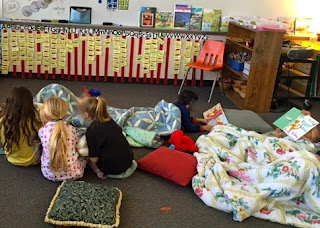 |
| Pajama Day! |
I hope you all follow Step 1 to “Find a Story. A good one,” and get caught reading in your classrooms, homes, back yards or wherever your favorite cozy reading spot may be. Happy Reading!
A few years back, I shared this photo with my students and with you, my readers:
I still carry it on my iPad and every now and then, someone will see it and ask where I got the picture. They are always surprised to hear I took it in our own town one day after work.
“I’ve never seen the sky look like that!”
Then there are the times my friends have shared sunset pictures that could easily make the cover of a coffee table book. When they tell me they took the picture the night before, I find it hard to believe I missed it. I was busy cleaning up when I could have been looking up. Sometimes we need a little nudge to catch the beauty around us.
Here’s one sunset I didn’t miss:
Shared beauty might inspire a poem or perhaps the shared beauty will be a poem. Like those found in When Green Becomes Tomatoes, Poems for all Seasons by Julie Fogliano, illustrated by Julie Morstad. I loved reading this book with my students.
,

From her poem
June 10
“ I don’t know much about flowers . . .
but I know how they lean
and bend toward the light
wide open as if singing
their voices (silent but everywhere)
fill up the daytime . . .
Well, I don’t know much about clouds, but I know sometimes they form waves (or dragons, if you have a good imagination), and sometimes they part to let the light shine in.

Poetry can do the same.
This year, Poem in Your Pocket Day falls on April 21 and my students will be ready with poems for their pockets and more for mine.
It will take a lot of poems to fill this enormous paper pocket but my students have been hard at work, filling it with their favorite poems and original compositions, like this one from a talented second grader:
I have nothing in my head.
It’s like an empty bed
where the fat cat jumped
to scratch
and catch.
by Tyler
He was still working on it when our session ended but he’s off to a good start.
When I searched for a new poetry collection to share with my students, I came across a book that is especially appropriate for the occasion, A POEM IN YOUR POCKET, by Margaret McNamara, illustrated by G. Brian Karas.
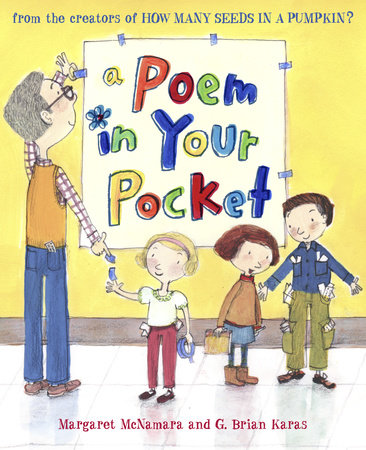
In this appealing story, Mr. Tiffin and his students prepare for an author visit. A famous poet is coming to their school for Poem in Your Pocket Day and the class is writing poems of their own in preparation. Elinor, a high achieving, top-of-the-class-type student, plans to write the perfect poem to read aloud at their assembly. She struggles day after day while piles of crumpled paper mound the floor beside her desk. Her patient teacher reminds her, “ . . . poetry is a messy business.”
This picture book introduces some tough concepts for my early elementary students, like “simile” and “metaphor.” But they had fun trying to come up with a few:
“A sunny day is like a sheep. Flowers are like lambs.”
Jenna, age 5
“Hugh is an angry bird.”
Cooper, age 6
“Thunder is like a roaring lion.”
Joel, age 7
In the story, when Mr. Tiffin took his class outside to look around with their poet’s eyes, one of his students said,
“Sadness is a cracked sidewalk.”
After hearing that line, Nico leaned in for a closer look at the illustration where a gray shadow touched the jagged line of a crack in a sidewalk. He was so engrossed; I stopped reading to give him a bit more time. A moment later he said, “I have a poem,” and he began to dictate as I wrote,
Cancer, cancer, cancer,
Pancer, wancer, cancer
Can kill you,
But maybe not!
Maybe you’ll be a dancer.
(Nico age 5)
I asked if he knew someone with cancer and he said, “Grandma, but she’s a cancer survivor!” What a big word for a five year old, and also a big concept.
Poetry gave Nico a means of sharing something important. When I read his poem back to him, his face flooded with light; his smile grew wide and his eyes glowed.
I hope you carry poems in your pocket this year and, like Nico, I hope those poems will shine light into the cracks of your sidewalk.
In preparation for this month, our school had a visiting poet working with students in their classrooms. Some kids missed speech sessions because of this and when one student came into my room and I explained why the rest of her group was missing, she wrinkled her nose and said, “I hate poetry!”
“What?!” My shocked reaction surprised us both. Then I asked, “Have you ever read a poem about a jellyfish?”
“No.”
Do you know what a jellyfish looks like?”
“No.”
I quickly pulled up a video of jellies on my iPad and I had her. Hazel was captivated.
By a lucky turn of events, only moments before Hazel came into my room, I’d read the poem, A Jelly-fish by Marianne Moore. I received this gem by email from the Academy of American Poets because I signed up for their “teach this poem,” a free weekly email for K-12 educators. They provide classroom activity ideas and, in this case, a video of Jellyfish.
When I started reading the poem to Hazel I realized right off we needed a vocabulary lesson. What eight-year old is going to understand every word in these first few lines?
Visible, invisible,
A fluctuating charm,
An amber-colored amethyst
Inhabits it; your arm
Approaches, and
It opens and
It closes;
You have meant
To catch it,
And it shrivels;
You abandon
Your intent—
. . .
I was afraid the challenging vocabulary would cause Hazel to lose interest but I was wrong. When we came to the end of the poem she asked if she could write one about otters. I couldn’t refuse such a request. Take a look at what she produced:
River otters
by Hazel
River otters swim fast!!!!
They glide through the water like a fish.
They are so cute.
If I had a river otter I would feed it every day.
I would take it out of the river and put it in my bed.
My bed would smell like fish sticks!!!!
When she finished her poem she wanted copies for her mom, her teacher, and our school nurse. Her feeling of accomplishment was obvious—and the look on her face—well that was pure poetry.
Happy Poetry Month—may it bring wonderful words and images into your world and into the lives of those around you.
(Check out “teach this poem”: https://www.poets.org/poetsorg/teach-poem)
I walked into a first grade classroom to pick up one of my students for speech and another child, who’d graduated from my program the year before, hurried over and said, “When do I get to go back to speech?”
“You don’t need my help any longer—you sound great!”
He’d met all of his goals the year before and his only remaining error was with the “r” sound. His speech was typical for a child of his age so I dismissed him from speech therapy in his kindergarten year.
“But I need help with the word, ‘bugga’.”
Oh, oh—I couldn’t understand him. “With what?” (Maybe he did need help.)
“Bugga.”
He didn’t give me additional cues, just that one pesky word.
“You mean burger?” I asked. “Like a hamburger?”
“No. You know, ‘bugga’.” And to help me out, he stuck his finger up his nose.
“Oh, I see. The “r” is giving you trouble.” I’d hate for him to go through life unable to pronounce that word!
He’s a little bit young to start working on “r” sounds, but it never hurts to bombard him with the correct pronunciation, especially when he gets to hear it in a story. I recently read a book that is a perfect match for him.
It has “r” sounds on every page. Here is a small sample,
In the jungle, toucans snooze.
Also sloths and cockatoos.
Ignoring snoring striped hyenas,
Monkeys dream they’re ballerinas.
But not Fred.
(The “r” is not enlarged in the book.)
EVERYBODY SLEEPS (BUT NOT FRED), written and illustrated by Josh Schneider will make a nice addition to his classroom as well as my own.
My students worked enthusiastically on one of the early Common Core State Standards (CCSS): “recognize and produce rhyming words” (Reading: Foundational Skills K.2) as they listened to the text and tried creating a few rhymes of their own. They worked on another CCSS when they “describe(d) the relationship between illustrations and the story in which they appear (Reading: Literature K.7).
The illustrations captivated them—pigs nodding off “in stinky rows” and sheep lying “in a wooly heap,” but their favorite was the anteater with his long probing tongue.
They came up with ideas for that tongue I would never have thought of, but my student who struggled with his “r” sounds would have appreciated their insights! They were certain that tongue would come in handy to get rid of . . . well, I’d rather not say but think of that pesky word above.
Books are flying off the shelves at Redwood Elementary this week. My speech students are so hungry for books that I’ve created a checkout system in the speech room so they can enjoy my personal collection. Read Across America is having its impact!
Our librarian, Kelly Sutton, has brought readers in from around our school and community to read stories to our students. The kids loved having our secretaries, nurse, and principal read with them and imagine their excitement when a local police officer took a turn in the reader’s chair! One special reader was Kelly’s own father.
The classroom teachers have been busy with Dr. Seuss activities; Lorie Wardlaw’s first grade class mixed up a delicious batch of green eggs and ham.
while Marcia Douglas’s first graders created green smoothies.
I missed the final product but the kids assured me, when this fruit went into the blender and they added kale, they had a lovely green drink.
Kathleen Murray’s kindergarteners lined our hallway with their Seuss inspired artwork.
I see future illustrators in this group!
On Wednesday, I had a chance to read to Ms. Kafin’s kindergarteners.
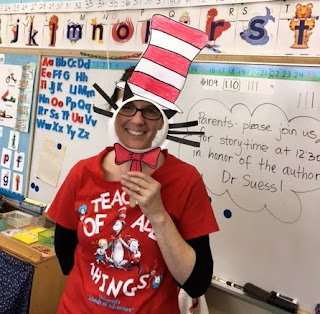 |
| Mrs. Kafin getting into the spirit of things |
I found a perfect book for the occasion: Surf’s Up by Kwame Alexander, illustrated by Daniel Miyares.
When a book can hold a surfing dude captive and keep him from riding the waves, you know it has power. And that is just what happens in this story. Two frogs named Bro and Dude, head to the beach with a book and board – a surfboard that is. As Bro reads, he can’t contain his excitement, crying “Wowie Kazowie” and “Booyah! They found the whale again.” His enthusiasm pulls Dude right into the story of Moby Dick and they ride this adventure like they ride the ocean waves. The kids were captivated by this riotous adventure and I must admit, I was too.
I hope Read Across America was a success in schools and libraries around our country, and I hope children everywhere experience the wild ride a good book can offer.
You may have noticed I haven’t been posting much for the past year. Instead, I’ve been busy working on other writing projects. I was nudged to get back to my blog when I received a digital review copy of the book I featured in my last post. Thank you, Marissa, for sending Calling All Cars my way! I’d forgotten how much I enjoy posting about books and engaging my students in the process.
Now that the review bug has bitten me again, I’ll be on the lookout for new books to share with my students and I’ll pass along our recommendations. While I wait for the next batch to roll in I thought I’d introduce one of my own that is frequently requested by my students, The Ghostly Night, written and illustrated by myself, Jeanette W. Stickel.
I wrote this story to give my students an engaging way to practice their “g” sounds. I had no idea how successful it would be. The kids continue to ask for this book even after mastering their “g” sounds.
In The Ghostly NightKristy can’t get to sleep.
“The wind rattled her window. The full moon threw grasping shadows across her bedroom wall. They swayed with the rhythm of the wind.”
Before long, Kristy calls her mother,
“Mom!” she cried. “There’s a g - g - g ghost in my room.”
She calls again when the wind howls, when a branch scrapes her bedroom window, and when she sees her curtains move. Each time, the kids join in “reading” the repeated line, “There’s a g - g - g ghost in my room.” They can’t seem to help themselves. That makes for a lot of practice with the “g” sound. It also gives them an understanding of the sound the letter represents, a phonemic awareness skill that fits right in with the Common Core State Standards (especially RF.K.3a where students are expected to “Demonstrate basic knowledge of letter-sound correspondences by producing the primary or most frequent sound for each consonant.”)
One teacher told me her whole class erupted in clapping when the tables turned on the Mother at the end of the story. You can imagine how pleased I was to hear that report—almost as pleased as I will be to introduce more stories to my students in the coming months.
I look forward to finding those special books to enrich the lives of my students and my readers.
It is hard to believe but this week we celebrated the 100thday of school. That special day ranks right up there with Valentine’s Day around our campus. Most teachers asked their students to bring in 100 items of their choice. Take a look at their clever ideas.


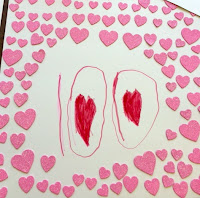
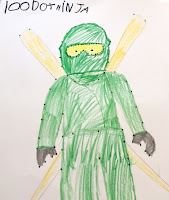
One of my speech students asked if we could read 100 books in honor of the day but we’ll have to make that a long-term goal. After all, we don’t want to rush through a good story.
And speaking of a good story, I was able to share a new book with a kindergarten class this week. They were thrilled to be part of a review team for Calling All Cars by Sue Fliess, illustrated by Sarah Beise.
Big cars,
Small cars,
Let’s call
All cars!
They loved the zippy text and, I must admit, I loved reading it to them. I couldn’t help but match my speed to the speed of the racing cars then slow for the climb over the mountain.
Zip through tunnels,
Make no stops,
Climb up over
Mountaintops.
The kids poured over the bright, eye-popping colors and giggled at the illustrations of a long-necked giraffe in a tiny convertible, a car with elevator wheels and adorable animals on every page. They each picked a favorite scene and their choices were as varied as the clever text and illustrations.
The students thought this was a great story for the 100thday of school because there were at least 100 cars in the book.
I’d say it was a good choice because their enthusiasm hit a full 100%!
It has been quite awhile since I last posted but my writing time has been well spent. I completed a middle grade novel, and now, before I start working on the next one, I thought I’d check in on my blog. Thank you all who continued to visit while I was away. I expected to find the number of views had plummeted, but what a surprise—they kept growing. I appreciate those of you who dropped by.
School is out and I’m on summer vacation so I won’t have many student stories to share but I do have a fabulous book to bring to your attention. My first read of the summer was HOW TO SPEAK DOLPHIN by Ginny Rorby, published by Scholastic Press.

I was drawn to this book for several reasons: first, I’ve enjoyed Ms. Rorby’s previous novels and assumed her writing would be as engaging as ever (I was right); second, Ginny Rorby is a friend of mine and I wanted to know what she has been up to in her writing life; third, Ms. Rorby did substantial research for this book in the autism class at the school where I work—with MY STUDENTS.
The narrator of this story, Lily, is big sister to Adam, a young child on the autism spectrum. You can’t help but root for this loyal, loving sister, whose family-life revolves around her half-brother. Her life takes a twist when her oncologist, step-dad, Don, is called in to assist in treating a young dolphin with cancer. Don brings Adam along, and when he meets Nori, a rescued bottlenose dolphin, a bond forms between them that crosses the communication boundaries inherent in Adam’s disability.
Adam is soon enrolled in a Dolphin Assisted Therapy program in hopes that his communication skills will improve. But when Lily sees how confining the environment is for the young dolphin, and realizes Nori may have to live in a chain-linked pen at the back of a pool for the next 37 years, she struggles between her loyalty to Adam and her desire to see this young dolphin freed from captivity.
Since several of my students are on the autism spectrum, I read the book with a critical eye to Ms. Rorby’s depiction of such a child. She did a brilliant job. Not only did she paint an accurate picture of Adam, she clearly depicted the family struggles surrounding a child with Adam’s particular cluster of autistic behaviors.
This story draws compassion from its readers—compassion for those with disabilities, their families, and for animals held in captivity.
I may not have shared stories about my students in this post, but Ginny did a fine job doing so. The main character in her book, Adam, is fictional, but his name and many of his characteristics are not. I work with the real Adam and with others in his class who exhibit the behaviors Ginny so accurately described.
When school rolls around in the fall, I’m glad I will have HOW TO SPEAK DOLPHIN on hand to share with my students, especially those animal-loving girls at our middle school. Perhaps their insights and our future discussions will make their way to this blog. I’ll keep you posted.
Welcome back, Jim Averbeck. Our Redwood students had such fun participating in an interview with you back in December of 2012—we’re overdue for a second one. Your book, The Market Bowl, was a hit with the kids and they’re full of questions for you.
FROM THE SPEECH ROOM:
Olivya: How long did it take you to write this book?
Jim: It took me probably 2 years all together. Even though it was very short, I wanted to make it perfect, so I re-wrote it many times. Plus I had to do all the art, which took about 9 months.
Riley: Did you use paint or crayons to make the pictures?
Jim: I used paint and also paper. I scanned everything into my computer and assembled the pieces there.
Ariel likes paints and paintbrushes and crayons and pencils and she likes to knit. She wondered if the blankets in the picture at the market were knitted.
Jim: Those things for sale at the market are called pagnes (pronounced pah-nyah). They are lengths of cloth that people in Cameroon wear either by wrapping them around their bodies or by sewing dresses and pants and other clothing from them. They have a kind of shirt they make from them called a boubou (pronounced booboo)
Maddie: Do you like writing stories?
Jim: I don’t like writing stories… I LOVE writing them.
Jacob doesn’t have any questions but he wants you to know he likes the part where Yoyo makes the yucky stew. He really loves the flies.
Jim: I liked the flies too. Poor Yoyo! No one liked her first stew except the goats.
Zayde: Why didn’t Brother Coin wear a shirt?
Jim: It can sometimes be very hot in Cameroon. In the part of Cameroon where THE MARKET BOWL is set, there is a traditional outfit the men wear which consists of a length of colorful cloth wrapped around the waist. It’s comfortable for them.
Skyler: Why did Yoyo make stew—why didn’t she cook brown eggs?
Jim: Mama and Yoyo did not have enough money to own chickens to lay any eggs. But the leaves for Ndolé grow wild in the rainforest, so they didn’t need to buy them.
FROM MS. MILLER & MS. JACKSON’S SECOND GRADE CLASS:
Allisyn: How does it feel to be an author?
Jim: Scary because I never know if anyone will buy my book. Like Yoyo and Mama, I depend on what I make to give me money for food and clothes and stuff. I wish I could get a blessing on MY market bowl.
The kids would bless your bowl if they could. But since they can’t do that, they’ve promised to spread the word about your book. They’re sure it will sell well.
Diego: When you were in school, did you do a lot of writing and drawing?
Jim: I liked to draw when I was little but I started writing stories because I loved to read, and I wanted to make stories like the authors I admired.
Kiara: Could you write a castle story?
Jim: I can start one. Maybe you can finish it. Here goes:
Eliana had a secret. Inside the left bottom drawer of the desk in her bedroom she kept a tiny castle. Not a toy castle, but a real one, with a tiny king and a tiny queen, who ruled all the people who lived inside the drawer. Eliana never opened the drawer all the way. She didn’t want to scare the tiny people, to whom she was a giant. But one day she had to open the drawer because…
If you could have seen the wide-eyed looks on the kids’ faces as I read Eliana’s secret, you would have had a hard time stopping but I’m glad you did. The beginning inspired the whole class and they are working together to finish the story.
Santiago: “How did you learn to be an artist?”
Jim: By doing art. I still struggle every day. It is hard because I see a picture in my head, but I can never draw or paint it as well as I see it in my head. But every time I try to make a piece of art, I learn something and I get better. Maybe I will be a really great artist someday.
The kids think you already are a great artist.
Sean: What is Yoyo’s dog’s name?
Jim: Ebobolo. (all the o’s are pronounced like the word “oh”)
Diego: Why does Brother Coin live in a cave?
Jim: Brother Coin is an ancient spirit. He has been around since before there were houses. He has a very elaborate and fancy cave with all the things he likes best, so he has never taken to houses, after they were invented.
Byron: Does Brother Coin have a brother?
Jim: He has a brother named Poverty and he also has a pet bull and a pet bear.
Santiago: How did you think of these ideas for the story?
Jim: Different ideas come from different places. Sometimes I dream them. Sometimes I write a word on the page and then think about things that are opposite of that word and how I might make a story out of opposite words. Sometimes I listen to things kids say and it makes me think of a good story idea.
Aubree: I like the story. Are there giraffes where Yoyo lives?
Jim: There are giraffes close to where Yoyo lives. She lives in the forest. The giraffes live on a grassy plain a long drive to the north of her.
Daniel: Do the people, where Yoyo lives, eat anything besides bitterleaf stew?
Jim: Yes- they eat lots of things. They eat some things that you and I might eat- spaghetti with tomatoes, peanut butter, and sweet potatoes. But they also eat crocodile, monkey and termites. I’ve eaten fried termites too. They are crunchy and salty like popcorn.
“Eewe!” That was the response from several of the students but others were hoping to try a few termites. We had quite a discussion about how people of other cultures might like some of the foods we eat.
Dmitri really liked the story and he said he learned a good lesson. He likes to sell his old stuff and he decided he will never again, refuse a fair price, even if it is just a quarter.
Jim: Just as long as he gets a fair price, he should do okay with that strategy.
I hadn’t intended to mention the Common Core State Standards (CCSS) during this interview but Dmitri’s comment nudged me to do so. The third Reading Standard for Literature asks second-grade students to “Recount stories, including fables and folktales from diverse cultures, and determine their central message, lesson, or moral.” I think Dmitri is on his way to meeting this one. Thank you for supplying us with an appropriate CCSS literature text, even if it wasn’t your motivation for writing it.
Jim: No problem. I am looking at my novel A HITCH AT THE FAIRMONT and making a CCSS guide for it. Maybe I should make one for MARKET BOWL too.
If you did, I know of several teachers who would put it to good use. That brings me to a question of my own, now that forty-five states have adopted the standards, will that influence what you write?
Jim: Not really. I quit a lucrative job to become a writer because I wanted to tell stories that delight me. I write for myself and have just been very blessed that people will pay me a little for my stories. I wouldn’t change that for CCSS. That said-- I will create and include more “informational text” as either auxiliary materials or as author notes in the actual book, to help teachers more easily access the research I’ve done to meet some of the standards and to give them a way to reach the fiction/nonfiction percentage mixes in one nice package. And I will create guides that give ideas for how to use the book to meet specific standards.
Wonderful! I’m sure your stories are delightful because they delight you. The CCSS guides will be useful but from my perspective, an engaging story has the most value of all.
To wrap up our interview, do you have any advice for young writers?
Jim: Just to remember that when they write something, if it isn’t the best they can do the first time, they can write it again and again until they are satisfied that it is as good as they can make it.
Great advice! I couldn’t agree more. Thank you, Jim Averbeck.
Mrs. Jackson’s class art project—Market Bowls sitting over flames:
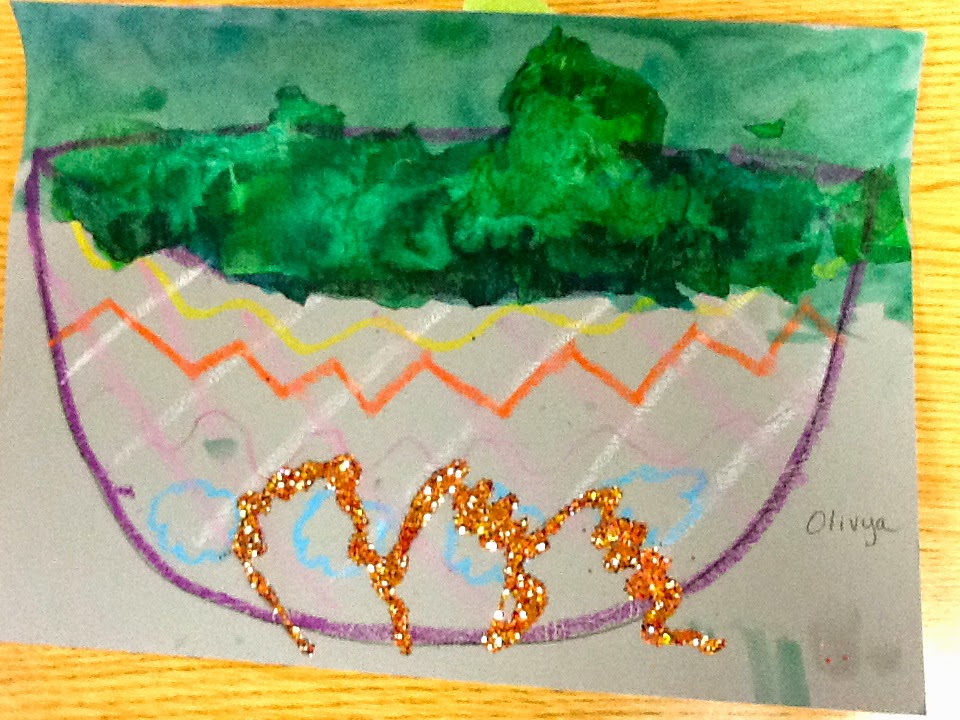
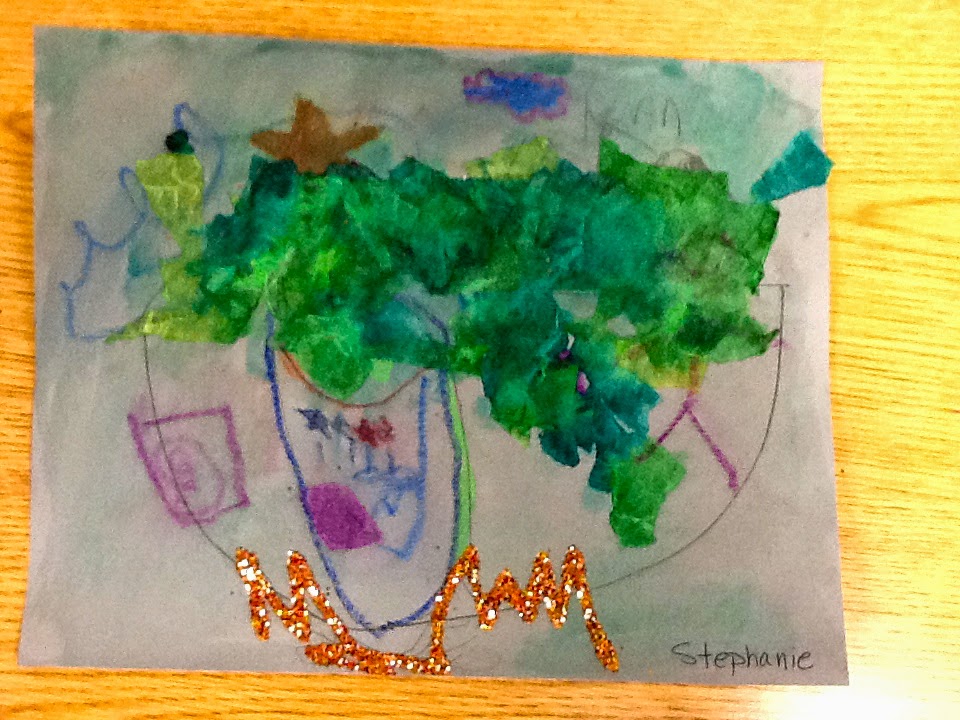
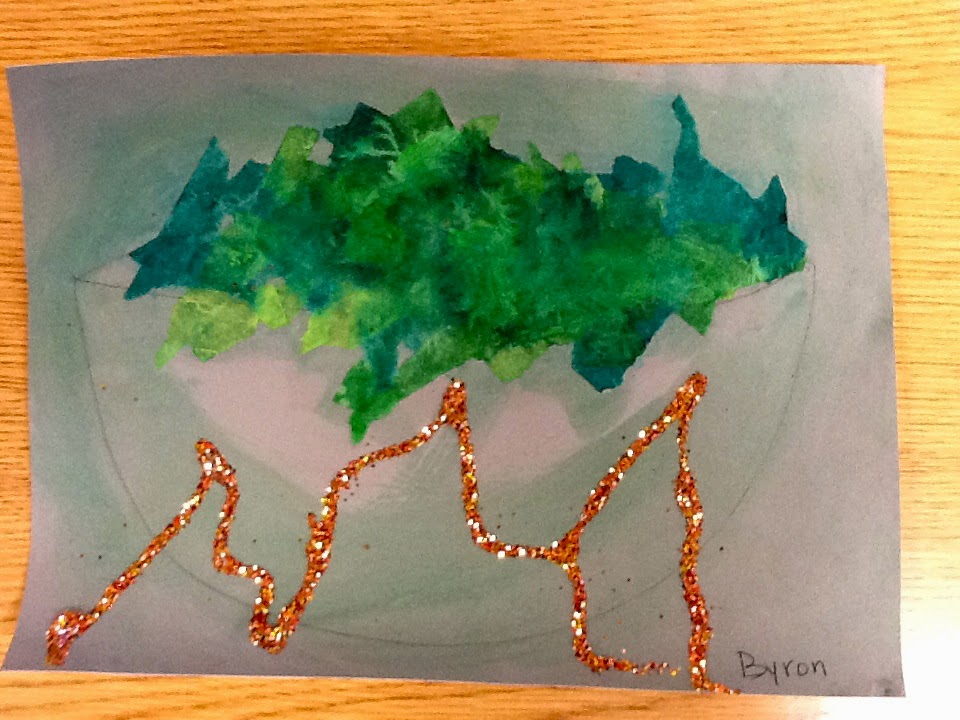
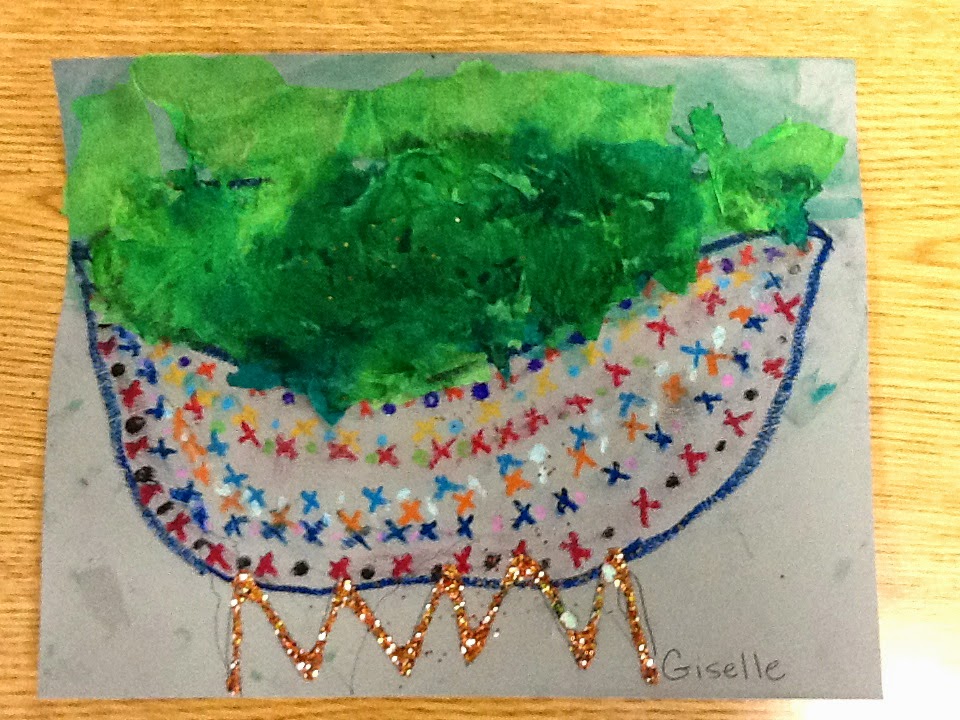
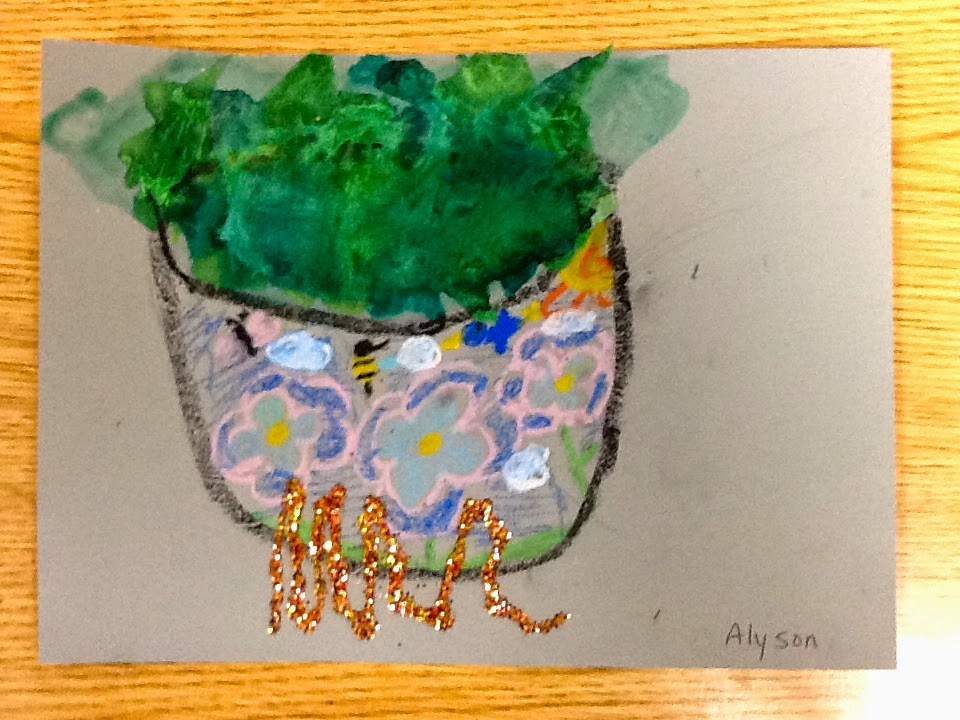

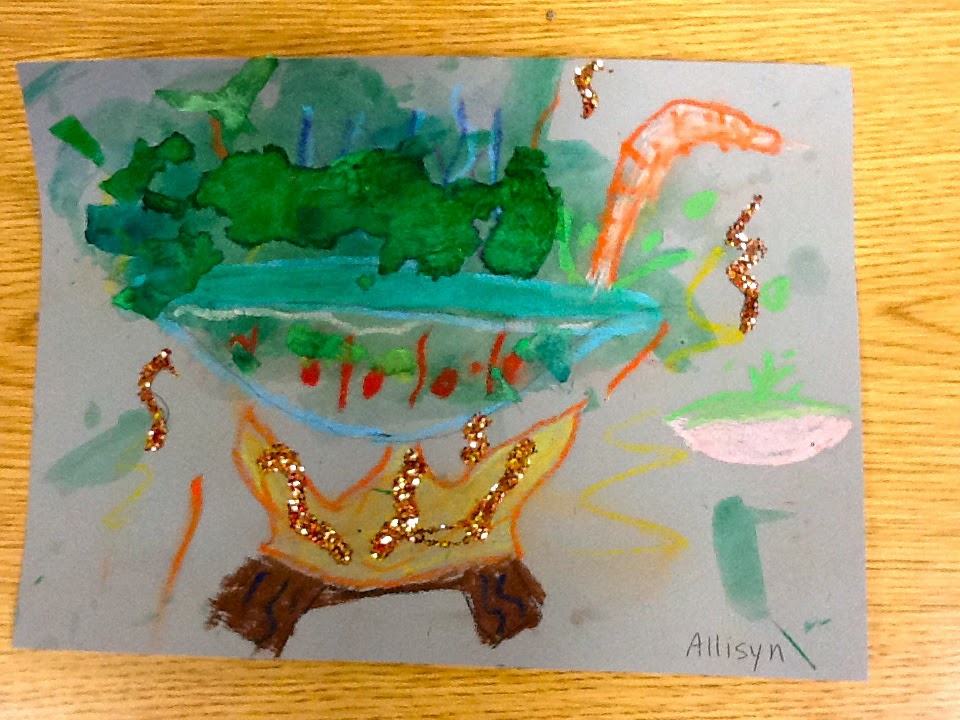
There is a lot of debate surrounding the CCSS but that’s healthy; after-all, in education you can be sure of one thing—change will happen and you can’t always be certain it’s for the best. Programs and approaches often cycle through our school systems with new names, minor (or major) changes and a big price tag. It makes sense to take a close and appraising look at the changes before hopping on board and spending our limited resources to do so.
That said, since the majority of the states in the US have adopted the standards, and we need to get on with our job of educating children, I’d like to look for creative ways to implement them. We don’t need to make extravagant purchases to begin. There are wonderful resources around our schools that will do the job effectively: good books, involved parents, dedicated teachers and librarians, like our very own Allison Brown who used her creative talents to raise funds to purchase new books for our students. She is aware of the new standards and was inspired by them to increase our selection of non-fiction books and refresh our selection of fiction.
Besides a shift to more non-fiction in our schools, the Common Core State Standards bring other changes.
I’ve been poking around the CCSS website to identify some of them (
http://www.corestandards.org/). When I read, “[t]he Standards insist that instruction in reading, writing, speaking, listening, and language be a shared responsibility within the school,” I realized that I too share that responsibility. I’m not a classroom teacher but I do support students in my role as a Speech Language Pathologist (SLP). Looking at the standards from my SLP perspective, I was surprised to discover that language skills are at the heart of most of them.
I work with students from kindergarten to those out of high school and it’s obvious to me— these kids are going to need strong language skills in order to meet the standards at every age. From the very first kindergarten reading standard, “With prompting and support, ask and answer questions about key details in a text,” a child will need appropriate language skills to achieve the goals.
This need is even more obvious when you come to the “Speaking and Listening” standards, like this one where second graders are expected to, “[t]ell a story or recount an experience with appropriate facts and relevant, descriptive details, speaking audibly in coherent sentences.” And how about the language standards, with their emphasis on grammar? That falls neatly in the SLP’s domain.
Even the math standards have a language component—first graders are expected to “Distinguish between defining attributes (e.g. triangles are closed and three-sided) versus non-defining attributes (e.g. color, orientation, overall size . . .) These kids are going to need a healthy vocabulary to be able to meet that one.
I was a little worried when I first read through the standards; I thought my caseload might jump to about 900 students. But then I remembered; I’m just support staff and lucky for me, our classroom teachers infuse language instruction throughout their days.
But this all brings me back to the reason for this post. Kids benefit when the responsibility for their education is shared across a school campus and within their homes. I’d like to suggest the responsibility spreads even further. I’ve introduced my students to some wonderful stories and non-fiction books written by authors from around the world. Each author has impacted the students in one way or another. And you can be certain; these books have provided a perfect springboard to work on several standards.
Last week, one of my first grade students came in asking for a story. He said, “I want the one with the carrots.”
“Which one?” I asked, “Tell me more about it.”
“You know, the one where the carrots followed the Rabbit everywhere and scared him, only he didn’t know for sure, he just saw orange all the time and then he’d turn around and it was just stuff like a bottle or curtains or a rubber duck.”
Of course, I quickly realized he was asking for Creepy Carrots! By Aaron Reynolds, illustrated by Peter Brown, but I didn’t want to interrupt his retelling of this fabulous tale. Little did Jacob know, he had just demonstrated impressive growth toward the second Reading Standard for Literature where first grade students are expected to, “Retell stories, including key details, and demonstrate understanding of their central message or lesson.”
I don’t think implementing the new standards needs to be a tedious proposition, at least not in the speech room. And since educating children is a shared responsibility, I’d love to hear suggestions from others, of how we all can effectively support children in meeting their goals, and ours for them.
Last week, toward the end of an exceptionally rainy day, three of my first grade speech students (all boys) came bounding into my classroom, overflowing with unspent energy. I had an appealing speech game laid out on the table, ready for this exuberant group, but as we started the activity, their wiggling bodies and wandering eyes made it obvious—their minds were not fully engaged. And so, with a quick sweep of my hand, I gathered the articulation pictures, folded up the game-board, and stood. They looked a bit worried when the game disappeared but their wrinkled foreheads cleared and their eyes sparkled when I said, “I think we need a story.” I had their full attention from the moment I spoke those words and their minds didn’t wander through the rest of the session.
Stories are powerful. Whether the students are listening to them, reading them or helping create them, I can’t think of a better way to reach a child or help a child reach their goals. Since that has long been my belief, I was delighted to find two story-related courses at the California Speech, Language and Hearing Association Convention last week. I guess I’m not alone in my desire to use literature with my students. The massive ballroom at the San Francisco Hilton was packed with speech therapists during both courses.
The first one, entitled Narrative Intervention: Teaching “Once Upon a Time” was taught by Teresa A. Ukrainetz, Ph.D., a professor at the University of Wyoming, in the division of Communication Disorders. From her first PowerPoint slide, I knew I had found a kindred spirit, or mentor, or story-telling guru, (after all, she has a Ph.D and has written numerous research articles on the subject.) But back to that first slide. Under the bold printed title, Why Narratives?, she listed, among other things,
Bridge between orality and literacy
Teaching language and literacy through stories
The magic of story
Parents and professionals, both, will easily catch the direction of her research findings. Stories build a bridge. What child, after hearing a good story, does not want to decipher those letters and watch them turn into words, then lift off the page to become unicorns or castles or wild horses running through their imagination? As Dr. Ukrainetz indicated, literature provides a perfect avenue for teaching speech, language and literacy skills, and that is when the magic happens.
Later that same day, I attended a course by Dr. Shari Robertson, a professor at Indiana University of Pennsylvania. This one was entitled, The Best of Both Worlds: Using Children’s Literature to Meet Oral and Written Language Goals. Once again, I was hooked by her first slide. This course was in the afternoon and after a heavy lunch, but I had no problem staying alert, even when she pulled out a picture book and read, what easily could have become, a bedtime story.
In the course description she stated, “Put some evidence-based zing into your therapy sessions by using books to target oral and written communication development.” Dr. Roberson put some zing into her entire presentation, and if I hadn’t already been enthusiastic about using literature with my students, I would have come away committed to doing so. As it was, I came away with fabulous new lists of books to use with my speech and language kids, one of which is a picture book written by Dr. Robertson herself—Capering Cows—the story of a sleepless child who counts cows instead of sheep.
This book, illustrated by Alexandra Crouse, is perfect for children who need practice with their “k” or hard “c” sounds and it is full of descriptive words and rhyming stanzas, like this one:
Cows that are cowardly
Cows that are brave.
Cows that have ears that waggle and wave.
The book includes tear-out flash cards for vocabulary practice and story extension activities. And at the back, you’ll find instructions on how to effectively use the book to address several National Reading Panel targets.
Dr. Roberson introduced other books produced by her publishing company, Read With Me! Press, which support language and literacy development. Speech therapists will especially appreciate the stories in their “Word Menders” series, which target specific phonological processes.
You don’t need to be a speech therapist or to understand those processes to read these stories to children. Elizabeth Redhead Kriston’s Go By Goat, charmingly illustrated by Gary Morgan, will help children listen to and pronounce the final consonants in words. Since this sound often disappears when some of my younger students speak, I’ll be putting the book to good use.
And when my exuberant speech group comes in for their next session, I’ll be armed with several new stories that are certain to delight them as we work toward their goals.
I received these books for review purposes. The opinions are completely my own, based on my experience. I was not financially compensated for this post.
I’ve had a productive blogging break. My middle grade novel is progressing well and now I’m letting it rest before my next round of revisions. I love the writing process (most of the time.)
I’m glad I’m not the only one who enjoys it. Over the last couple of months, I’ve found some wonderful books for my students. Books that would not be nearly as wonderful if their authors hadn’t taken time to polish their prose. This week, the kids reveled in the story, language, and illustrations in How to Be a Pirate, by Sue Fliess, illustrated by Nikki Dyson.
Of course the subject matter was appealing from the start. I haven’t met too many children who don’t adore a good pirate story. The students' eyes never strayed from the page as I read,
“Ahoy, landlubber!
Come with me.
Board me ship upon the sea!
Not a pirate?
Don’t know how?
Ye can learn to be one now!
Come in closer—
I don’t bite.
A pirate ye shall be tonight!”
My language students had fun correcting a few pronoun errors when those rascally pirates used “me” instead of “my”. They also had a chance to practice their rhyming skills by identifying and predicting rhymes in the text. I was afraid the story would be too “young” for my second-grade speech students, but I was wrong. When they saw the book on my shelf, they let me know they didn’t want to miss out, so I grabbed the story and put it to work. It was a perfect match since I’d started targeting “r” sounds with this group. The kids were delighted to help the pirates say, “arrr matey!” And with all the “r” words in the text, like “pirate”, “crossbones”, “swagger”, “buccaneer” (just to name a few), they had plenty of words to use for practice.
To accompany the story, I found a variety of parrot coloring pages on the Internet. My younger students each chose one to decorate. Take a look at the pirate parrots:
The second grade kids got very creative with their artwork. These are their own designs:
These lessons were a lot of fun for me and for the students but if you think we were merely having a good time, you’re mistaken. We addressed various Common Core State Standards (CCSS) while using this book. For example, in the Reading Standard: Foundational Skills K.2, kindergarteners are expected to “recognize and produce rhyming words” and in the Language Standard 1.1, first grade students are asked to use correct pronouns and past tense verbs. They had a lot of practice as they identified rhymes, retold the story, and caught pirate language errors.
The standards apply to my articulation groups as well. From “Listening and Speaking” to “Reading; Foundational Skills,” speech therapy fits neatly into several CCSS areas. The kids might not recognize the standards we’re addressing in speech but my “r” group knew exactly which sound they were working on with
How to be a Pirate. As they created their artwork, I heard excellent pirate growls, “arrrrr,” from all around the table.
This story turned out to be an inspired choice for motivating my students. When Zayd left my classroom on Tuesday, he turned and said, “This is cool. Can we work on our r’s again tomorrow?” That was an easy “yes.” We followed up the next day with a review of the story and I heard perfect “r” sounds exploding all around the table. I have high hopes for all these eager pirates, both those with language delays and those with simple articulation errors. I’m certain their enthusiasm will lead to growth in the coming weeks and more good stories will likely fuel that enthusiasm.
There’s definitely a holiday spirit around our school this week. Take a look at some of the artwork from our halls and classrooms:
Our school librarian, Allison Brown, added to the festive spirit by producing over 300 elegant stars. They decorate our halls, classrooms and library windows, creating a holiday atmosphere. But she didn’t hang them merely to adorn our school; these stars are lighting the way to new books for our shelves.
Parents, students, and teachers alike, are snatching up the stars for a mere five dollars, and all the proceeds are going to purchase new books—like the one Alison read to our students yesterday:
Over the winter break, I plan to read some new books myself, sitting in front of a crackling fire with a cup of hot cider in hand. Our family will celebrate Christmas together and perhaps make a few more ornaments to commemorate the year. Like this one we made in honor of our trip to San Francisco to watch the Nutcracker several years back.
Or this one we created of our red Toyota on one very memorable trip into the woods to cut down a tree. (We were lucky to make it safely home.)
I’ll use some of my winter break for writing projects. If you’ve been following my blog, you may remember, I didn’t post during the summer in order to concentrate on a middle grade novel I was writing. The first draft is finished but it’s hard to fit in revisions with a full-time job and a weekly blog. And so, I’ve decided to take a break from posting until I’ve completed another draft—or two, or three. I can hardly wait to dig in! I’ll be back posting from my speech room later in the school year and fill you in on my progress.
Happy holidays! Thank you all for reading and I’ll see you in 2014.
View Next 25 Posts






















